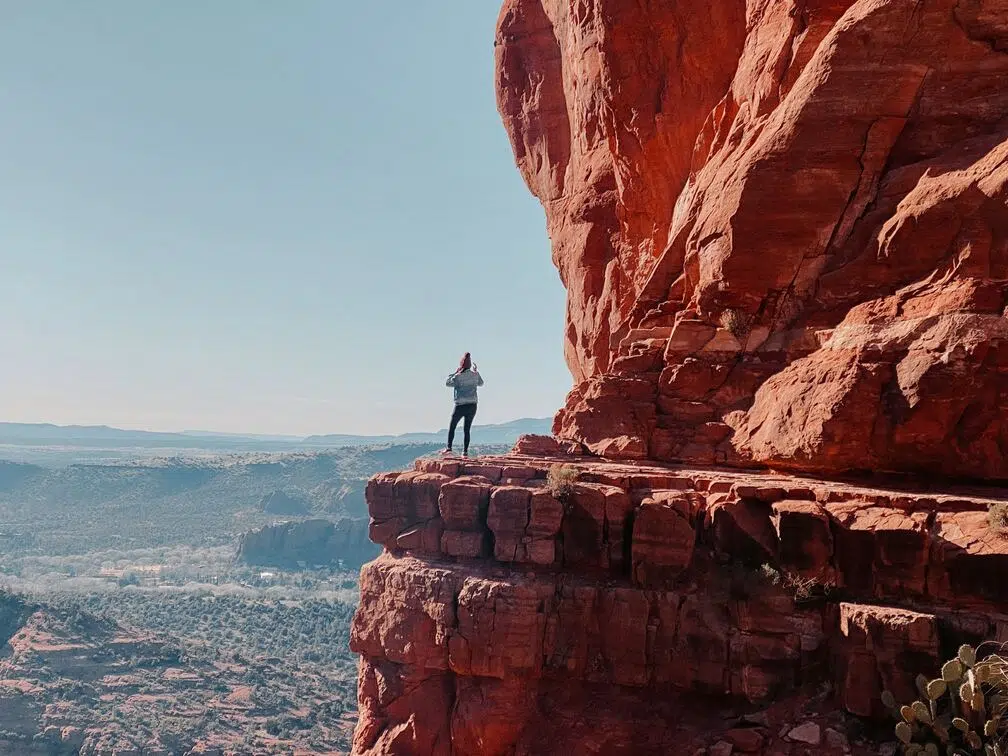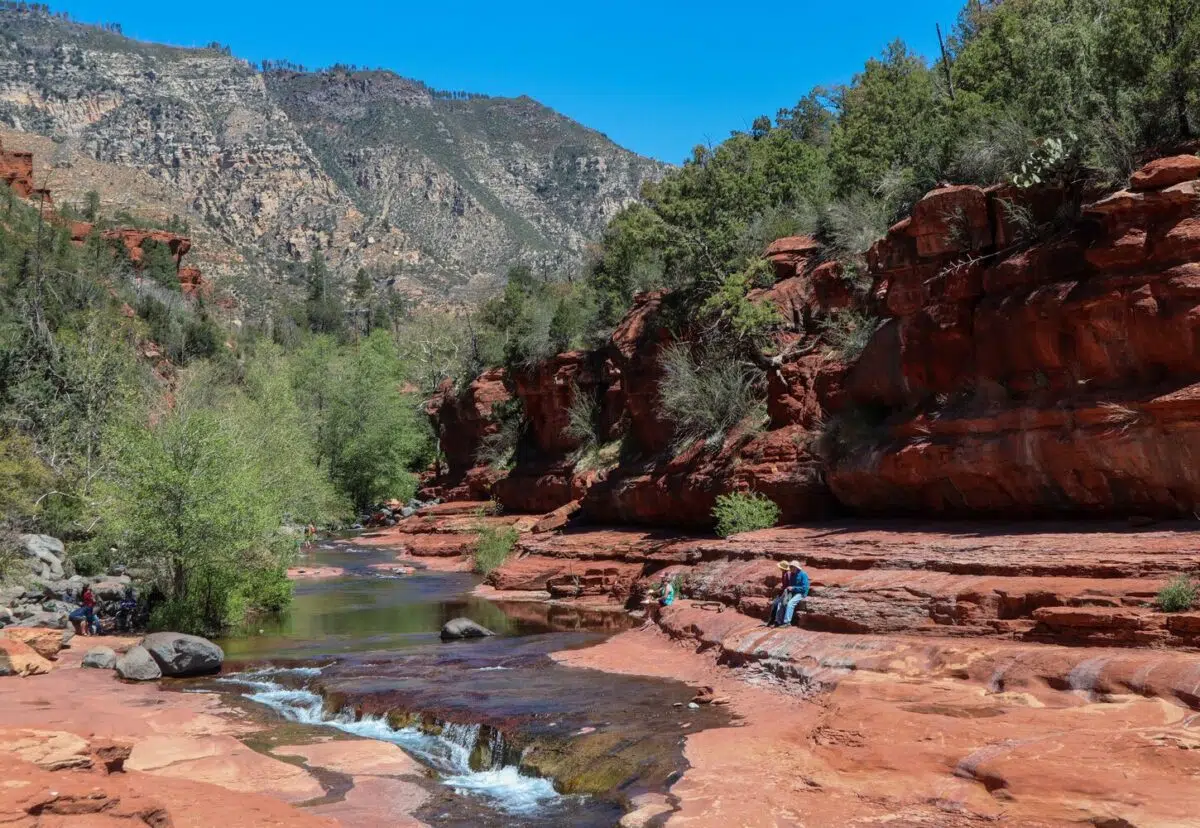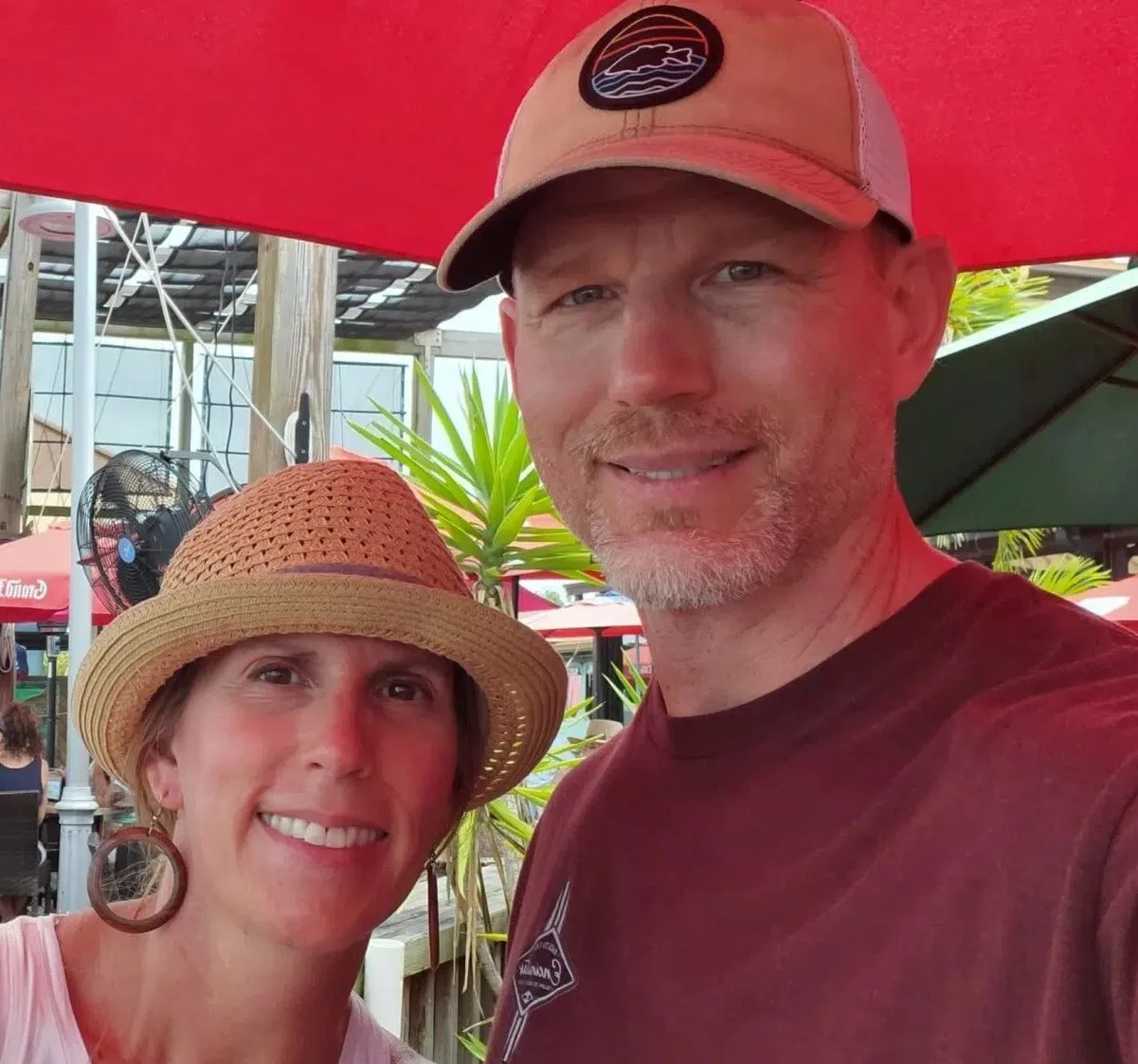
While Arizona’s national parks, like the iconic Grand Canyon, tend to bask in the spotlight, its state parks offer beautiful landscapes and unique experiences. Arizona has incredibly diverse ecosystems, from the desert floor to remote swimming holes, and its state parks put this variety on full display.
Michelle Thompson from Arizona State Parks and Trails puts it this way: “Arizona’s more than 30 parks are great because they really showcase the diversity of the state of Arizona. This is a unique state with so many things to see and do, and incorporating a state park into a visit is a great way to enjoy how much Arizona has to offer.”
Arizona is one of the hottest places in the US, literally and figuratively. If you want adventure beyond the ordinary, set your sights on these extraordinary state parks in Arizona.
Tonto Natural Bridge State Park
Tonto Natural Bridge is a must-visit spot twenty miles northwest of Payson, Arizona. At 183 feet tall, it is considered the world’s largest travertine bridge. Hiking is a popular way to explore the park, but there are parking lot viewpoints if hiking is not for you.
The state park has several short yet challenging hiking trails. Pine Creek trail is one of the best routes, but it requires good hiking shoes and sure footing. The beginning of the trail is developed, then hikers follow the creek bottom over rocks and around trees to the base of the bridge.
The view from underneath the natural bridge is fantastic. And depending on the time of year and water flow, you can soak up the mist from a small waterfall which is an excellent way to cool down when the temperatures heat up in the summer.
Once you reach the base of the bridge, visitors will see what looks like a swimming hole, but unfortunately, swimming is not allowed in the pool. The footing can be slippery under the bridge due to the mist from the waterfall, so hike cautiously and wear good shoes. But there is plenty of shade, and the mist is enough to keep you cool as the temps rise.
Tonto Natural Bridge State Park is also a great place to see wildlife. The resident javelinas are large and in charge. You are in for a treat if you have never seen one of these creatures. Rabbits, deer, and various birds also call the park home.
Pets are not allowed on the trails. If you plan on hiking this Arizona state park, please leave Fido home.
Finally, visitors can explore the park store, visitors center, and museum, which details the history of the park and this beautiful region. There are no campsites in the park, but there are day-use ramadas for rent and plenty of other free areas to sit for a picnic.
This natural beauty is worth the two-hour drive from Phoenix to escape the summer heat and explore Arizona‘s “rim country.” The entry fee is $7 per person.
Catalina State Park
Catalina State Park is home to roughly 5,000 iconic saguaro cacti, and it’s an excellent spot to spend a day if you are looking for things to do in the Tucson area.
This Arizona state park sits at the base of the beautiful Santa Catalina Mountains. It has a campground, hiking, biking trails, and an equestrian area for horse lovers. The park has 120 campsites, each with electricity and water, perfect for tents or RVs.
Hiking is popular here, with trails for all skill levels. Beginners will enjoy the one-mile Nature Trail, while expert hikers can trek along the 9-mile Sutherland Trail with an elevation change of 5,900 feet.
Catalina State Park is an excellent base camp for nearby attractions, including Biosphere 2, Saguaro National Park, Picacho Peak State Park, and the Pima Air and Space Museum, a short drive away.
About twenty minutes north of Tucson, the park is easy to get to and gives visitors a more remote vibe even though it’s close to town.
Dead Horse Ranch State Park
The Ireys family arrived from Minnesota in the 1940s looking for a ranch. One property had a dead horse by the road. Mr. Ireys asked his kids which ranch they liked. “The one with the dead horse,” they replied. The name stuck. When the state acquired the park in 1973, the family required the parks department to keep the name.
Dead Horse Ranch is one of Arizona‘s most popular state parks for good reason. There is a lot of fun stuff to do here. Visitors can enjoy fishing for largemouth bass in one of the lagoons or paddling the Verde River. The park has over 100 RV campsites with water and electricity. In addition, Blackhawk Loops has sites dedicated to tent campers.
Many other attractions, including Sedona, Slide Rock State Park, the historic town of Jerome, and Tuzigoot National Monument, surround the park, so there is a lot to do in the area if you are up for a day trip.
The park is open year-round, but spring and fall are especially nice seasons to visit. It does get cold at night here late fall through early spring. We just about froze here tent camping one late October weekend, but that’s another story.
Lake Havasu State Park
While Lake Havasu has earned a well-deserved reputation as a spring break paradise, nestled on its shores lies Arizona‘s most visited state park. Lake Havasu State Park draws about a half million visitors annually for camping, fishing, boating, and other outdoor activities.
Whether you prefer tent or RV camping, the state park has plenty of campsites, all with electric hookups and access to potable water. There are showers and restrooms onsite; each camp spot has a fire ring and picnic table.
Please note that the weather is hot here for a good chunk of the year, making air conditioning necessary for warmer months. My family stayed here in mid-October when the temperatures were around 100 degrees during the day. We ran the air conditioning in our camper 24/7 during our stay. Late fall, early spring, and winter are excellent times to visit the park and avoid the heat.
If camping isn’t your thing, Lake Havasu State Park has cabin rentals with beautiful water views. Renting a cabin is a great way to spend a weekend. The cabins include bunk beds, a queen bed, and electricity, so you have heating and air conditioning. Each cabin has a barbecue pit, fire ring, and picnic table outside and is a short walk to the showers.
Finally, the shimmering waters of Lake Havasu provide a fishing haven for anglers. With a rod in hand, anglers hunt for various species, including bass and catfish.
Slide Rock State Park

Nestled in the beautiful red rocks of Oak Creek Canyon, Slide Rock State Park is a fantastic spot to cool off during the hot summer months. The park is 7 miles north of Sedona, so it’s easy to get to and is one of the best things to do if you visit Sedona in the summer.
Slide Rock also made the Travel Channel’s list of America’s top swimming holes. The park’s namesake slide is a natural, smooth 80-foot slide carved into the sandstone. Algae cover the sandstone, which makes for a slippery surface. For adventurous people, there are a few cliffs you can jump off into the refreshing pools below. And, if cliff jumping or sliding is not for you, there are plenty of areas for wading and pools to swim and cool off.
Since the park is so popular in the summer, it’s best to get here as early as possible. The temperature heats up, and the parking lot fills up quickly, especially during peak season (Memorial Day through Labor Day) on the weekends.
Bring a cooler, chairs, water toys, etc., and you can set up camp along the red rock banks of Oak Creek, and many visitors take towels or beach chairs.
Although the slide is the main attraction here, hiking and fishing are popular activities. Fishing is prohibited in the swimming area, but anglers can walk upstream for excellent trout fishing. There are some short hikes within the state park, and the surrounding Coconino National Forest has a lot of great trails.
Lost Dutchman State Park
Legend has it the Lost Dutchman Gold Mine lies in the Southwestern United States, in the general area of the Superstition Mountains near Apache Junction. Every year, People visit, some risking their lives searching for the treasure.
Lost Dutchman State Park is about 45 minutes due east of Phoenix, at the base of the Superstition Mountains. The park is a popular spot for visitors who enjoy camping and hiking. There are 135 well-maintained campsites for RV and tent campers, and more than half have water and electric hookups.
For those who love to explore, Lost Dutchman has an extensive network of hiking trails for all skill levels. Spring is a popular hiking season, with beautiful weather and a chance to see vibrant spring wildflowers and native wildlife. Nature photographers flock here in the spring to capture the park’s natural beauty against the steep mountain backdrop.
For seasoned hikers, Siphon Draw Trail is a must. The 4-mile round trip hike winds through Siphon Draw Canyon with 1,000 feet of elevation gain. Siphon Draw Trail is also a gateway to the Flatiron, a steep trail with a lot of vertical climbing. Many hikers take to the park as an easy access point to the Flatiron, which doesn’t have a designated trail but provides unparalleled views of the area.
One thing that sets Lost Dutchman State Park apart from others is the cabin rentals which are an excellent way to spend a night or a weekend with beautiful views of the Superstition Mountains. If you want to relax after a hard day hiking or exploring, cabin rentals are a great way to go.
The cabins have electricity, heating, and air conditioning, so it’s a great spot year-round. The cabins have one queen bed and two bunk beds, making it an ideal spot for families. If tent camping isn’t your jam, renting a cabin is an excellent option to experience all the park offers without sleeping on the ground.
Picacho Peak State Park
Traveling east from Phoenix to Tucson on Interstate 10, Picacho Peak is hard to miss. This distinctive mountain is recognizable from miles away and is the centerpiece of the state park. The park draws visitors from Phoenix, Tucson, and those just passing through.
Hiking is a great way to explore this Arizona state park, with hiking trails leading to the peak that provides panoramic views of the vast desert landscape. From the top of Picacho Peak, hikers can see for miles, and the vehicles traveling on the freeway look like tiny toys compared to the immense scale of the desert.
The park has hiking trails for all levels, though the trails rated “difficult” are the ones that lead to the best view from the top. Regardless of skill level, lace up your hiking boots for a trek through the beautiful Sonoran Desert.
Another favorite pastime here is camping. With 85 campsites, both tents and RVs are welcome. Each site has electric hookups, fire rings, picnic tables, and access to WiFi for an additional charge. Some sites have ramadas that provide necessary shade from the sometimes intense sun.
Pets are welcome at Picacho Peak State Park. Just remember to keep your pup on a six-foot leash at all times.
Expect to see some of the usual desert suspects regarding wildlife, rabbits, birds, deer, coyotes, etc. Of course, rattlesnakes call the area home and are most prominent when temperatures rise.
Finally, feel free to enjoy the visitor center, where you can learn about the history and geography of the area. There is also a gift shop inside the visitor center for unique gifts you can’t find anywhere else.
Entrance fees are $7 per vehicle, and campsites range from $25-30 depending on the season. Note that if the visitor center isn’t open, you will need cash to pay the fee, so make sure you have the exact change.
Oracle State Park
Oracle State Park fits the bill if you are looking for a hidden gem. It’s a unique, out-of-the-way State Park close to the Biosphere 2 science research facility, Tucson, the scenic Santa Catalina mountains, and Catalina State Park.
The park is located in Oracle, Arizona, about an hour northeast of Tucson, on the north side of Mount Lemmon. The park has fifteen miles of hiking trails, picnic areas, and group sites. At roughly 4,300 feet elevation, it’s cooler than areas like Phoenix and has a variety of trees and other vegetation.
Park visitors can tour the Kannally Ranch House, a 50,000-acre ranch at its peak. Tourists can explore the historic four-story house and see what ranching in the southwest was like in the early 1900s. The top floor of the house has a small visitor center and a gift shop. The visitor center is great for learning about southern Arizona’s unique geology and history.
Exploring the lower levels of the Kannally Ranch House, one thing that caught my eye was a large, modern telescope. Since the park is far from light pollution, Oracle State Park is designated as an International Dark Sky Park, making it an excellent spot to enjoy the night sky. Be sure to call ahead to make arrangements if you are interested.
Arizona state parks are great for spotting wildlife, and here you will find javelina, deer, rabbits, coyotes, and bobcats. You might run into the occasional rattlesnake, depending on the time of year.
The cost to enter the park is $7 per vehicle, and there are nice flush toilets with running water onsite too.
Events
Some of the parks have events throughout the year. For instance, Catalina State Park has “Catalina Nights,” a nighttime nature hike, on the first and third Friday of the month. Lost Dutchman State Park has family campouts and a “Desert Scorpion Hunt.” Check the state parks website for events at specific parks before you head out.
Get Out and Enjoy These Arizona State Parks
Arizona‘s state parks offer diverse landscapes, each with a unique history. Whether you want to hike the rugged trails or stargaze under beautiful desert skies, these state parks promise an incredible experience.
This article originally appeared on Savoteur.

Steve is the owner of Paddle About, a blog that’s all about helping people get out and enjoy nature. He loves to kayak, camp, hike, and spend time outdoors with his wife and two kids. When he’s not out exploring the great outdoors, Steve enjoys writing about his adventures and sharing tips for getting the most out of your outdoor experiences. He has a lot of interesting stories to share, and he’s always happy to help others get more out of life.


